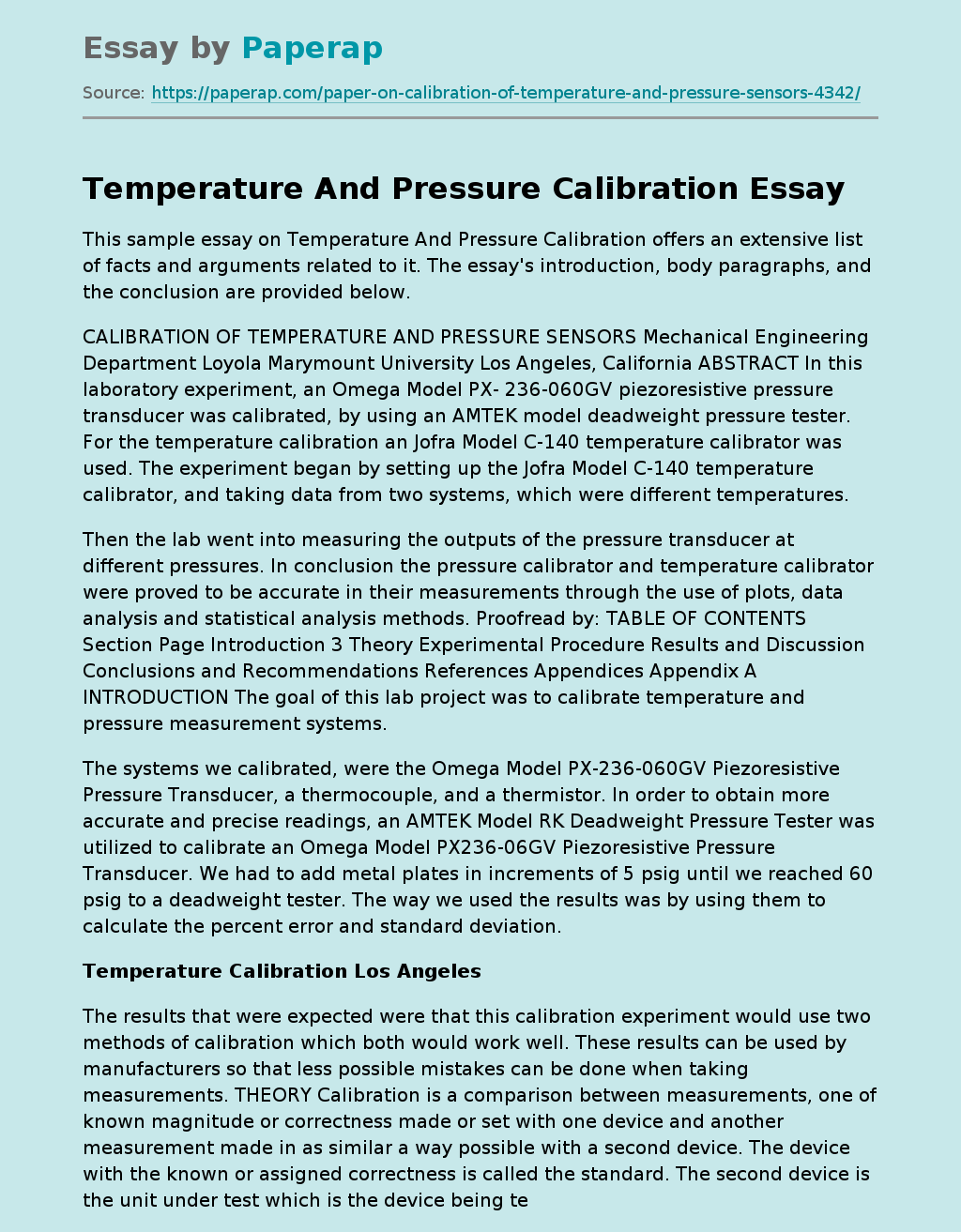Calibration of Temperature and Pressure Sensors
The goal of this lab project was to calibrate temperature and pressure measurement systems. The systems we calibrated, were the Omega Model PX-236-060GV Piezoresistive Pressure Transducer, a thermocouple, and a thermistor. In order to obtain more accurate and precise readings, an AMTEK Model RK Deadweight Pressure Tester was utilized to calibrate an Omega Model PX236-06GV Piezoresistive Pressure Transducer. We had to add metal plates in increments of 5 psig until we reached 60 psig to a deadweight tester. The way we used the results was by using them to calculate the percent error and standard deviation.
The results that were expected were that this calibration experiment would use two methods of calibration which both would work well. These results can be used by manufacturers so that less possible mistakes can be done when taking measurements. THEORY Calibration is a comparison between measurements, one of known magnitude or correctness made or set with one device and another measurement made in as similar a way possible with a second device.
The device with the known or assigned correctness is called the standard. The second device is the unit under test which is the device being tested.
Furthermore temperature calibration is tested using thermocouple and a thermistor. The thermocouple is a junction between two different metals that produces a voltage related to a temperature difference. The thermistor is a semiconductor device that has a negative temperature coefficient of resistance, in contrast to the positive coefficient displayed by most metals.
Instrument calibration is one of the primary processes used to maintain instrument accuracy.
Calibration is the process of configuring an instrument to provide a result for a sample within an acceptable range. Eliminating or minimizing factors that cause inaccurate measurements is a fundamental aspect of instrumentation design.
Although the exact procedure may vary from product to product, the calibration process generally involves using the instrument to test samples of one or more known values called “calibrators. ” The results are used to establish a relationship between the measurement technique used by the instrument and the known values. The process in essence “teaches” the instrument to produce results that are more accurate than those that would occur otherwise. The instrument can then provide more accurate results when samples of unknown values are tested in the normal usage of the product.
Calibrations are performed using only a few calibrators to establish the correlation at specific points within the instrument’s operating range. While it might be desirable to use a large number of calibrators to establish the calibration relationship, or “curve”, the time and labor associated with preparing and testing a large number of calibrators might outweigh the resulting level of performance. From a practical standpoint, a tradeoff must be made between the desired level of product performance and the effort associated with accomplishing the calibration.
The instrument will provide the best performance when the intermediate points provided in the manufacturer’s performance specifications are used for calibration; the specified process essentially eliminates, or “zeroes out”, the inherent instrument error at these points (Advance Instruments Inc. ). The table below shows the data voltage of the pressure transducer when the weight plates are added in increments of 5psig. One of the observations done was that as the pressure increased then the percent error would decrease.
My assumption is that as the weight kept increasing then it started to make the small un-calibrated weight difference ignorable. The graph below shows the true pressure versus the outputted voltage from the pressure measuring system.
The accuracy and precision of the system is shown in the equation shown on the graph where the slope as it is close to 1 shows accurate measurements. Graph 1: True Pressure vs. Output Pressure The table below shows the data collected from the thermocouple and the thermistor. The percent error part comes from using only the thermocouple data not the thermistor. The temperature measurement system seems to be more precise than the pressure system since the percent errors are smaller and not vary as much.
The graph below shows the true temperature versus the indicated thermocouple temperature. From the data we can see that as the temperature increased also the accuracy of the thermocouple. The standard deviation of the thermocouple was 21. 52, and the standard deviation for the thermistor was 21. 23.
CONCLUSION AND DISCUSSION:
- When the pressure increased, the accuracy also increased
- When the temperature increases the thermocouple became more accurate
- The two calibration methods were proved accurate through the results of the data analysis
- One recommendation would be to repeat the calibration test in order to have the absolute precise accuracy.
Calibration of Temperature and Pressure Sensors. (2019, Dec 06). Retrieved from https://paperap.com/paper-on-calibration-of-temperature-and-pressure-sensors-4342/

